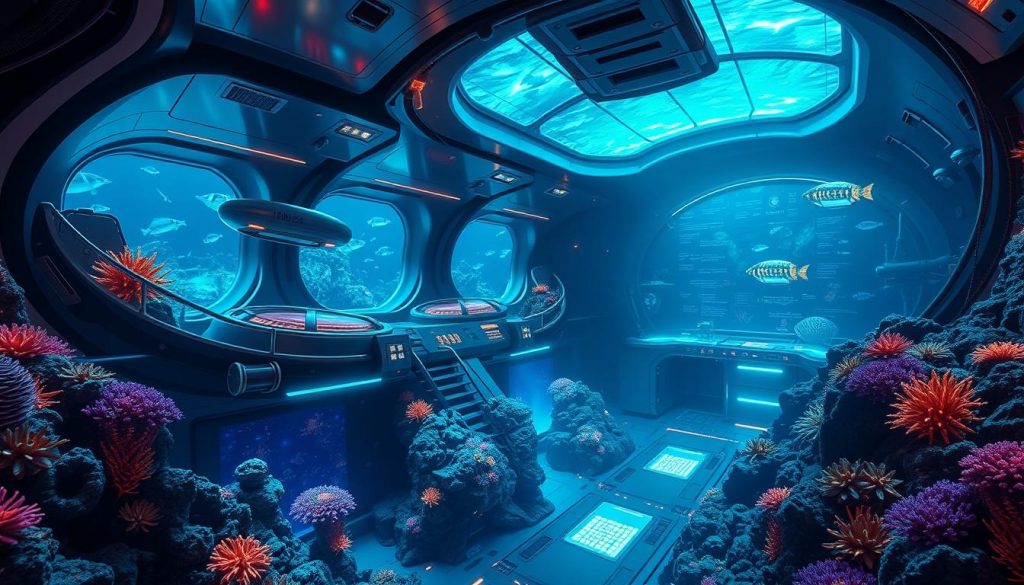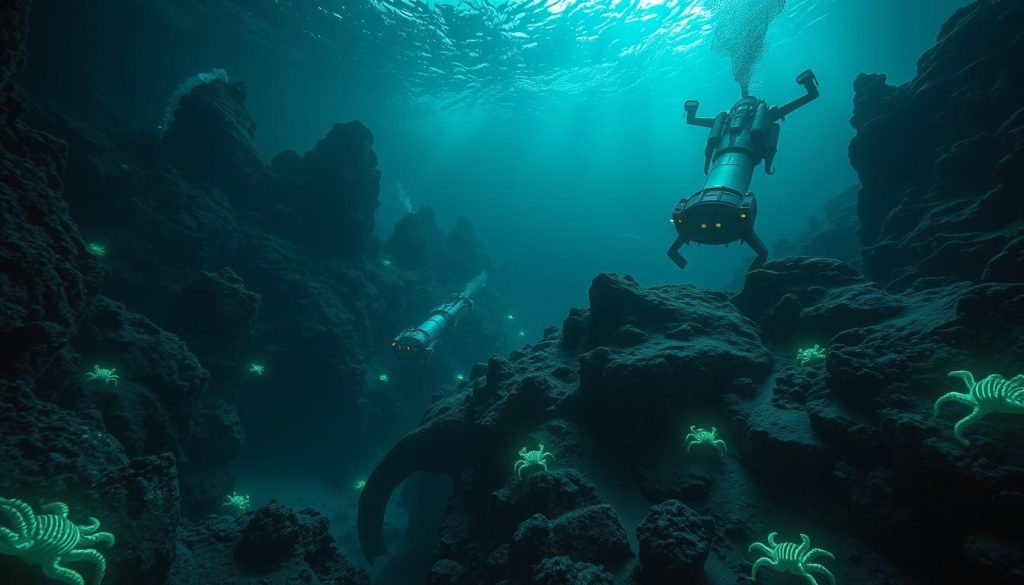Exploring the deep oceans: Technologies unveiling an unknown world.
The oceans cover more than 70% of our planet. Yet, NOAA says 95% of the underwater world is still a mystery. New deep-sea technology is changing how we explore the oceans.
Anúncios
Innovative tools like Remotely Operated Vehicles (ROVs) and Autonomous Underwater Vehicles (AUVs) are key. They let researchers explore places once thought unreachable. This is opening up new areas of study in marine ecosystems.
These tools are vital for studying underwater habitats and the ocean floor. For example, TOBI has done 63 research cruises. It has shown how trawling harms coral systems. These technologies are helping us discover thousands of new species.
Ocean exploration is also helping us understand marine biodiversity. It gives us clues about how climate change affects these ecosystems. As we improve underwater technology, we may uncover the ocean’s secrets.
The Importance of Ocean Exploration
The depths of the oceans are full of mysteries that are key to our health. Most marine ecosystems are still unknown. This makes exploring the oceans very important.
Anúncios
Deep-sea areas have resources like oil, gas, and rare minerals. These are crucial for our economy. Also, deep-sea fishing gives food and jobs to many people.
Climate change is a big threat to our oceans. It affects how they absorb carbon and changes weather worldwide. Knowing this helps us deal with problems like rising sea levels and more storms.
Exploring the ocean helps us find new medicines and treatments. It’s important for our future. The health of our oceans is linked to global challenges.
New technologies will help us map and explore the oceans better. Working together is key. It shows we must protect our oceans for the future and tackle climate change.
To learn more, visit the importance of ocean exploration.
The Mystery of the Deep Ocean
The deep ocean is a vast, unexplored area of our planet. It is filled with mysteries and secrets. More than 80% of the ocean floor is still a mystery to us.
The darkness at great depths is home to unique marine life. These creatures have evolved to survive in the dark. They have developed special ways to adapt to their environment.
Many animals in the deep ocean can light up the darkness. This is because they have bioluminescence. It helps them find mates and avoid predators.
Some creatures, like deep-sea octopuses, take care of their eggs for up to five years. This shows how diverse and complex life in the deep ocean is.
Deep-sea ecosystems are also shaped by features like hydrothermal vents. These vents can have water hotter than 350°C (660°F). Yet, they support life, showing the incredible diversity of the deep ocean.
Marine snow, made of dead organisms, is a key food source for many deep-sea creatures. It shows how connected life in the ocean is.
Exploring the deep ocean is challenging. The pressure and lack of oxygen make it hard. But, scientists are working hard to uncover its secrets.
By exploring these unexplored seas, we can learn more about our planet. It’s a vital effort to understand the deep ocean’s mysteries.
Advancements in Deep-Sea Technology
Recent progress in deep-sea technology has changed how we explore the ocean. New tools allow scientists to collect data and images from deep areas. The Kraken Robotics SeaVision laser scanner creates detailed 3D images of the seafloor.
Remotely operated vehicles (ROVs) are key in deep-sea research. The ROV Seirios has been helping since 2011. It works with other ROVs like the Deep Discoverer, which has new cameras for better images.
The Medusa lander caught the first giant squid footage in 2019. This shows how new tools reveal the deep ocean’s secrets. NOAA used video from these tools to discover a new jellyfish near Puerto Rico.
Autonomous underwater vehicles (AUVs) are also important. The Vityaz-D AUV went 10,028 meters deep in 2020. New laser technology helps send data faster underwater.
Telepresence technology lets people watch ocean expeditions live. NOAA’s Okeanos Explorer streams its missions in high definition. The Ocean Observatories Initiative also shares live video from Axial Seamount every three hours.

Key Missions in the Deep Sea
Deep-sea missions are key to learning about marine life and ecosystems. The 2021 North Atlantic Stepping Stones mission by NOAA was a big step. It used advanced tech to map the New England Seamounts and find new benthic habitats.
This mission found coral gardens and seafloor features we didn’t know about. These finds are crucial for marine biology discoveries.
Remotely operated vehicles (ROVs) like Deep Discoverer (D2) have changed how we explore the deep sea. D2 can go down to 6,000 meters (3.7 miles) and has 27 LED lights to light up the dark. It also has a suction sampler with six canisters for collecting samples.
New tech has made it easier to control ROVs in real-time. This helps scientists observe and collect data more effectively during missions.
Deep-sea exploration has reached many milestones thanks to hard work. For example, in 1977, Alvin found hydrothermal vents. This discovery changed how we see life without sunlight.
NOAA’s ongoing missions are vital for science and conservation. They keep making new marine biology discoveries that help us understand and protect the ocean.
Impact on Marine Biodiversity
Deep-sea exploration shows us how delicate underwater ecosystems are. It helps us understand how species interact and live in specific places. This knowledge is key to keeping these ecosystems strong as the environment changes.
Research shows that almost two-thirds of life in the deep sea can’t be classified. This highlights the vast and complex life forms in the deep. It also shows why we need to protect these areas.
It’s believed that up to 10 million species live in the deep sea. Over 90% of these are in the Clarion Clipperton Zone (CCZ) and haven’t been discovered yet. Finding new life forms tells us we must act fast to save them.
Deep-sea mining is a big worry for marine habitats. Mining can create huge plumes of sediment that harm the ocean. This can disrupt the balance between species and make conservation harder.
The International Union for Conservation of Nature (IUCN) says nearly 10% of marine species are at risk. This means over 1,550 species out of 17,903 are facing extinction.
New technologies like digital monitoring help us understand marine life better. These systems can spot changes in the ocean with over 90% accuracy. They help us fight pollution and climate change more effectively.
The value of marine biodiversity is huge, estimated at $2.5 trillion to $5 trillion a year. Using sustainable practices is crucial. Working together across different areas can lead to better conservation results.
| Marine Biodiversity Facts | Statistics |
|---|---|
| Estimated number of species in the deep sea | 10 million |
| Percentage of CCZ species undescribed | Over 90% |
| Global marine species at risk of extinction | 10% |
| Economic value of marine biodiversity | $2.5 – $5 trillion per year |
| Reduction in illegal fishing with effective surveillance | Up to 50% |
Challenges of Deep Ocean Research
Exploring the deep oceans is tough. Scientists face extreme conditions like intense pressure. For example, the Mariana Trench has pressure of around eight tons per square inch.
This pressure is a thousand times more than what we experience at sea level. It makes it hard to do research down there.
Funding and logistical issues add to the problems. Getting money for deep-sea research is tough. It’s all about showing how it will help society.
Recently, a $50-million upgrade to the submersible Alvin was made. This shows how technology is improving. But, it also means more money is needed for these projects.
Every step forward in research comes with a cost. It requires careful planning and teamwork from many people.
The impact on the environment is another big concern. More human activities lead to more marine litter. This is a big problem in the deep ocean.
We need to be careful not to harm these delicate ecosystems. New technologies, like visual-inertial odometry for navigation, help reduce risks.

Working together and sharing resources is key. International cooperation and sharing help tackle the challenges. This includes using robotic systems and autonomous technologies.
Places like NASA play a big role in this. They help improve our ability to explore while protecting our oceans.
Discoveries from Ocean Exploration
Ocean exploration has changed how we see marine life. Recent trips have shown us vibrant underwater worlds, like colorful coral gardens. These discoveries show the amazing variety of life in the sea.
For example, scientists found unique creatures like worms and snails in deep-sea vents. These findings show us how life can thrive in extreme places. They also remind us of the importance of exploring these areas.
The oceans have warmed by over 1.5°C since the Industrial Revolution started. This change affects marine life and ecosystems. It’s key to understand how these changes impact our oceans.
Also, research has found high levels of siderophores in the ocean’s twilight zone. This suggests changes in how life works in these areas. Knowing this helps us protect these environments.
Groups like the National Oceanic and Atmospheric Administration (NOAA) are mapping the ocean floor. The Seabed 2030 Project, for example, aims to finish a detailed survey by 2030. This will reveal more secrets of the deep.
As we get better at exploring, we’ll find more in the ocean. Future trips will explore deep waters and search for new medicines. Exploring the ocean is crucial for learning about our planet’s depths.
Future Directions for Deep-Sea Technology
The future of deep-sea technology is exciting, with a focus on innovation and sustainability. The ocean covers over 70% of our planet, making ocean exploration crucial. Researchers are working on better ROVs and AUVs, equipped with advanced sensors and AI.
These tools will help us understand ocean processes better, especially how climate change affects them. Subsea drones and underwater robots are becoming important too. They help us explore deeper and do it in a way that’s kinder to the ocean.
Only about 25% of the ocean floor has been mapped so far. We need to map more and get more detailed data. Autonomous underwater gliders are a big step forward, staying underwater for months before needing a recharge.
Working together, schools, governments, and companies will push these innovations forward. They need to create charging stations for underwater gear, which requires a lot of money and standardizing power connectors. The future of deep-sea tech looks bright, leading to a more sustainable way of exploring and managing our oceans.
Conclusion
Understanding our oceans is key to knowing our planet’s health and resources. Deep-sea technology is crucial for exploring, monitoring, and protecting marine life. We’ve seen amazing biodiversity and learned about global environmental changes.
The future of marine research depends on using these advanced technologies wisely. We must tackle the challenges of deep-sea exploration head-on.
Advances in underwater vehicles and energy systems have opened up new possibilities for deep-sea research. Projects to study hybrid energy systems at great depths show our dedication to sustainability. Yet, we must be careful not to harm marine ecosystems, especially with risks from deep-sea mining.
We need to invest more in ocean exploration. This will help us protect our oceans and their benefits to humanity. By working together, we can ensure the health of marine ecosystems for future generations.
